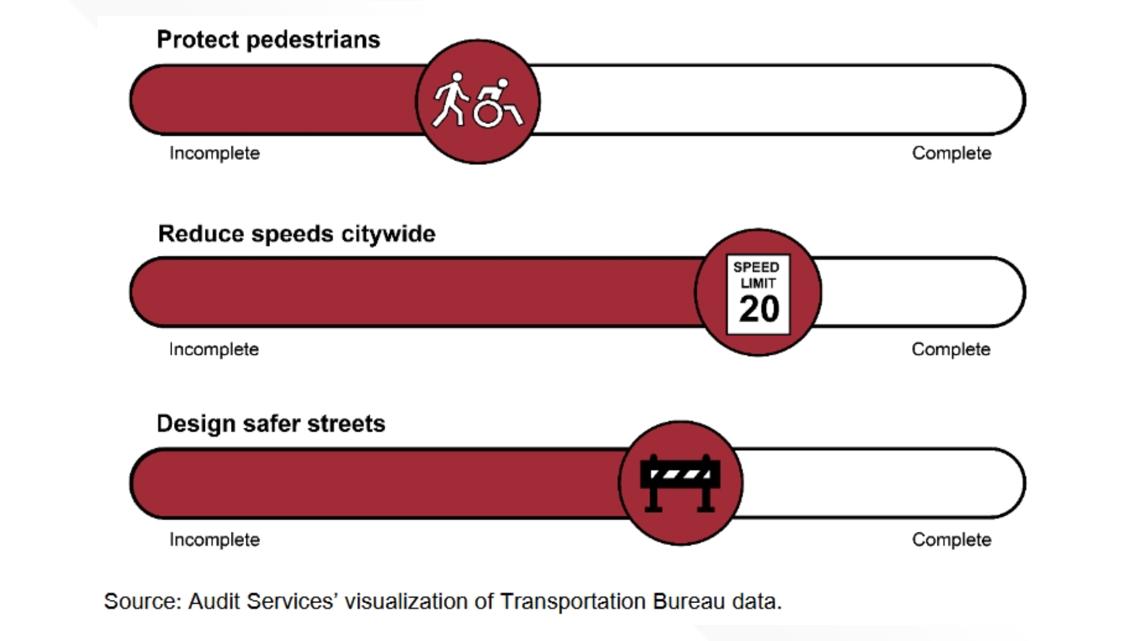PORTLAND, Ore. — The Portland Bureau of Transportation is falling short on its goal to reduce traffic deaths and crashes, according to an audit released by the Portland City Auditor on Wednesday.
The audit centered on PBOT's Vision Zero initiative, which was adopted by Portland City Council in 2016 with the goal of moving towards zero traffic deaths and serious injury crashes.
While Vision Zero has completed some of its strategies focused on pedestrian safety, it needs to "systematically evaluate whether completed safety projects are effectively reducing fatalities and serious injuries," said Portland City Auditor Simone Rede in a news release.
After city council adopted Vision Zero in 2016, crashes declined — but they started to rise in 2020, according to the audit. There were 64 traffic fatalities in Portland in 2021 and 63 in 2022. Preliminary data shows 69 deaths were recorded in 2023, the audit said.
In 2019, PBOT updated its action plan and divided it into four strategies with specific actions for them: protect pedestrians, reduce speeds citywide, design streets to protect human lives, and create a culture of shared responsibility.
Findings of the audit
The audit said PBOT's biggest strategy commitment was to protect pedestrians by adding street lighting, changing signal timing and providing crossings in between intersections. While the bureau made some safety improvements, it did not add as much lighting or crosswalks as anticipated, the audit said. In particular, the bureau didn't finish installing lighting on two high-crash corridor streets that were identified in its 2019 plan. PBOT cited things like the pandemic, hiring freezes and supply chain issues as reasons for falling short in this area.
When it comes to speed, the Oregon Department of Transportation sets speed limits for the state. One bright spot noted in the audit: PBOT gained some control from the state to reduce most residential speed limits to 20 mph. However, the audit said the bureau could do more to enforce speed limits.
"The one area where they have fallen short in this strategy is the installation of promised speed cameras, which help in the enforcement of speed limits, one of the objectives under this strategy," the audit said.
In terms of designing safer streets, PBOT noted that more than half of its projects to improve safety on high-crash streets were completed on time. Others were delayed due to hiring freezes, split staffing and supply chain delays, the bureau said.
The graphic below, taken from the audit, shows PBOT's progress in completing three of its four strategies.


The auditor said it did not look at PBOT's projects tied to creating a culture of shared responsibility because the outcomes of that strategy were not easy to count.
Recommendations from the city auditor
The audit recommends that PBOT conduct routine, systematic evaluations of completed safety projects to determine whether they are working and which ones best shift the trend towards zero traffic deaths and serious injuries. The bureau's policies state that performance measures should be used to evaluate the transportation system's overall performance, but according to the audit, PBOT staff said that isn't always done.
"The Bureau is constantly working on a variety of safety projects, but those projects are not systematically evaluated once they are completed," the audit said.
It also found that there is some confusion within PBOT as to which projects fall under Vision Zero.
The audit also said that the bureau could do more to focus on smaller safety projects that have an equitable impact. Between 2019 and 2022, 22% of traffic fatalities happened in lower-income areas and communities where Black, Indigenous and people of color live.
"East Portland is home to most of the deadliest streets and intersections in the city, which makes it less safe to walk in that section of the city," the audit said. "Not only are pedestrians in East Portland more than twice as likely to be killed in a traffic crash than those walking in other areas of the city, but the majority of all traffic fatalities also occur east of the Willamette River."

